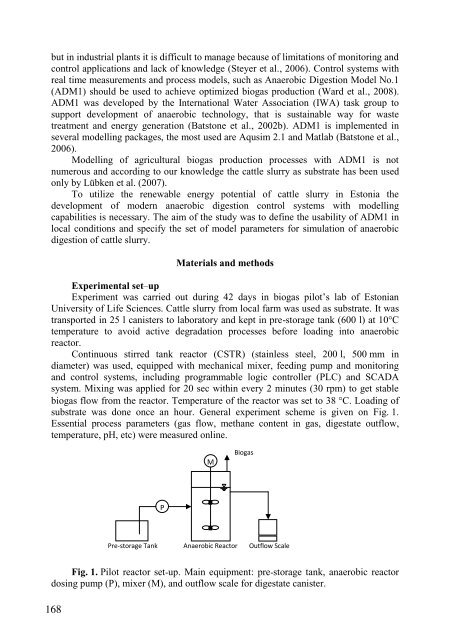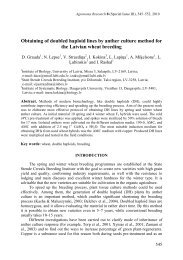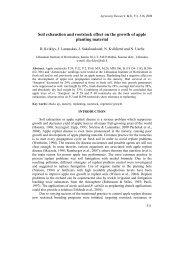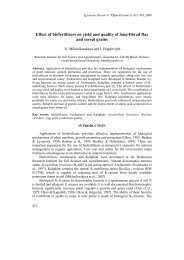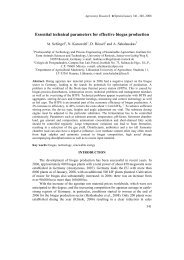Simulation of anaerobic digestion of cattle manure - Agronomy ...
Simulation of anaerobic digestion of cattle manure - Agronomy ...
Simulation of anaerobic digestion of cattle manure - Agronomy ...
Create successful ePaper yourself
Turn your PDF publications into a flip-book with our unique Google optimized e-Paper software.
ut in industrial plants it is difficult to manage because <strong>of</strong> limitations <strong>of</strong> monitoring and<br />
control applications and lack <strong>of</strong> knowledge (Steyer et al., 2006). Control systems with<br />
real time measurements and process models, such as Anaerobic Digestion Model No.1<br />
(ADM1) should be used to achieve optimized biogas production (Ward et al., 2008).<br />
ADM1 was developed by the International Water Association (IWA) task group to<br />
support development <strong>of</strong> <strong>anaerobic</strong> technology, that is sustainable way for waste<br />
treatment and energy generation (Batstone et al., 2002b). ADM1 is implemented in<br />
several modelling packages, the most used are Aqusim 2.1 and Matlab (Batstone et al.,<br />
2006).<br />
Modelling <strong>of</strong> agricultural biogas production processes with ADM1 is not<br />
numerous and according to our knowledge the <strong>cattle</strong> slurry as substrate has been used<br />
only by Lübken et al. (2007).<br />
To utilize the renewable energy potential <strong>of</strong> <strong>cattle</strong> slurry in Estonia the<br />
development <strong>of</strong> modern <strong>anaerobic</strong> <strong>digestion</strong> control systems with modelling<br />
capabilities is necessary. The aim <strong>of</strong> the study was to define the usability <strong>of</strong> ADM1 in<br />
local conditions and specify the set <strong>of</strong> model parameters for simulation <strong>of</strong> <strong>anaerobic</strong><br />
<strong>digestion</strong> <strong>of</strong> <strong>cattle</strong> slurry.<br />
168<br />
Materials and methods<br />
Experimental set–up<br />
Experiment was carried out during 42 days in biogas pilot’s lab <strong>of</strong> Estonian<br />
University <strong>of</strong> Life Sciences. Cattle slurry from local farm was used as substrate. It was<br />
transported in 25 l canisters to laboratory and kept in pre-storage tank (600 l) at 10°C<br />
temperature to avoid active degradation processes before loading into <strong>anaerobic</strong><br />
reactor.<br />
Continuous stirred tank reactor (CSTR) (stainless steel, 200 l, 500 mm in<br />
diameter) was used, equipped with mechanical mixer, feeding pump and monitoring<br />
and control systems, including programmable logic controller (PLC) and SCADA<br />
system. Mixing was applied for 20 sec within every 2 minutes (30 rpm) to get stable<br />
biogas flow from the reactor. Temperature <strong>of</strong> the reactor was set to 38 �C. Loading <strong>of</strong><br />
substrate was done once an hour. General experiment scheme is given on Fig. 1.<br />
Essential process parameters (gas flow, methane content in gas, digestate outflow,<br />
temperature, pH, etc) were measured online.<br />
P<br />
M<br />
Biogas<br />
Pre-storage Tank Anaerobic Reactor Outflow Scale<br />
Fig. 1. Pilot reactor set-up. Main equipment: pre-storage tank, <strong>anaerobic</strong> reactor<br />
dosing pump (P), mixer (M), and outflow scale for digestate canister.


